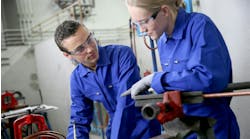Latest from Best Practices
Sponsored
There is an old saying that a rising tide lifts all boats. What this essentially means is that we all benefit from an industry on the rise. And while we might not all be in the same boat, we’re all affected by the same tide. So, it makes sense that manufacturers and professionals in the plumbing and HVAC industry should partner to learn from each other, share best practices and provide strategic forward progress with products and technology. This will not only benefit individuals and companies, but also the industry as a whole.
I’ve been a trainer all my life, and watching someone grasp a concept that was previously unclear or misunderstood is one of the sheer joys of my job. To be able to offer greater understanding and clarity on a subject can be life-changing and inspiring to witness.
Offer training
After years in the HVAC business, I became a customer trainer for a manufacturing company — offering training on plumbing, radiant heating/cooling and fire sprinkler systems. It was such an eye-opening experience to discover how many industry professionals were interested in learning more about their trade and also to see how much technology was changing and continuing to evolve.
The commitment to training and education has been a cornerstone of the company, which began its training legacy back in the mid-1980s and continues today with a state-of-the-art, 11,000-sq.ft. training facility and applications lab. We also provide some of the best field training in our industry, with field technicians and manufacturer’s reps throughout North America. We do this to ensure our customers have the very latest information and education for our industry to equip them to be both competitive and proficient.
Innovations are changing the marketplace faster than ever. And these innovations reach the marketplace faster than ever as well. It is true that, in today’s world, you can lose jobs just by not keeping up with some of the current innovations. We want our engineers, contractors and installers to have the latest of these innovations in hand, and be trained and educated on how to use and install them. That, in turn, will give them the best possible lead in a very competitive marketplace.
For example, the newest courses we have added to our curriculum relate to large-dimension PEX pipe, which is proving to be a real game-changer in the commercial plumbing and hydronic distribution piping world. Its reduced cost, ease of installation, reduction in the number of connections made, and theft deterrent as compared with copper are making PEX a viable and cost-effective alternative to copper. To that end, we have added courses for engineers, contractors and installers that equip them to work with the product in all types of commercial and multifamily residential construction.
Shortage of tradespeople
On-the-job labor is one career that cannot be outsourced. One sure way to lower unemployment is to direct attention back to one of the country’s all time strengths — our skilled trades. If you want to strengthen the middle class and create small businesses, there is no surer way of doing it than investing in our skilled trades. And the skilled trades provide a launching point into many other career paths related to the trades, such as sales, project management, building management, manufacturing and wholesale-distribution.
There are hurdles to overcome, to be sure. A survey done by RIDGID, a supplier of tools, reveals that a scant 6% of high school students hope to have a future career in the skilled trades — defined as plumbers, carpenters, electricians, HVAC or repair, according to the article “A Ridgid Survey Reveals Top and Bottom Career Paths” published in Reuters dated Feb. 4, 2009.
Meanwhile, the 2008 economic downturn hit the construction industry particularly hard, with estimates that one-third of all construction contractors went out of business. In the latest report from the U.S. Department of Labor Statistics for the plumbing industry alone, we are going to need an additional 82,300 employees on top of replacements for the number of people who will be retiring. The job outlook for the next 10 years is projected to be 21% higher than all other industries and jobs. That’s an incredible opportunity!
Comparing the two charts from the Department of Labor Statistics reveals a 12-year overall downturn in the number of plumbers currently employed from 2001 to 2012. However, Figure 2 reveals we will be at an all-time high for employed plumbers by the year 2016, eclipsing the highest recorded number of all time.
Obviously, the way we are currently doing things to entice people into our industry is not working as well as we would like. Thus, maintaining the status quo will not turn the tide.
The RIDGID survey revealed that the number-one reason for high school students not entering the skilled trades was “lack of knowledge about the industry and the overall perception of the skilled trades.” We don’t have a labor problem as much as we have an awareness and image problem. So, where do we begin?
When they’re young
Today, our middle schools and high schools are driving our young people to believe that a college degree is the best and often the only way to ensure a good economic future. For some, this can be true; but it’s not for everyone. This is why it is so important that we, as an industry, attend annual high school job fairs to provide awareness of what a career in the trades can offer.
The RIDGID survey revealed that once high school students were introduced to the skilled trades and what they had to offer, 60% of the students said they were more interested in working in the trades. However, due to cost constraints, Industrial Arts classes in high schools around the country are being removed at an alarming rate, which only exacerbates the existing problem of awareness for the skilled trades career path. Without receiving an introduction to the trades in high school, there is little incentive or awareness to lead students to further education in vocational schools, so the process has to begin at the high school level (or even earlier).
It’s also a good idea for manufacturers to partner with trade schools: It’s a win-win partnership. Obviously, the company benefits from the exposure to a future generation of potential customers, but the students also benefit by receiving key insights into product use and installation techniques that can offer them a leg up on the competition in the job market.
Mentor, partner
Relationships, relationships, relationships! My training partner, Wes Sisco, and I have more than 70 years of experience in the trades. While we have accumulated a fair bit of knowledge over the years, more importantly, we have had the privilege of working side by side with some of the classroom teachers who are in the trenches day in and day out. Most of them have come from the trades themselves. These are the unsung heroes who are bringing along the next generation of skilled trades people.
We have also found that it is important to join with other groups who are similarly trying to advance the industry. Mark Eatherton of the Radiant Professionals Alliance (IAPMO) comes to mind as an example of someone dedicated to passing the baton to a future generation, and there are many more like him. The more knowledge and information we pass among one another, the greater the awareness grows.
And, lastly, I would highly recommend that everyone in the industry mentor someone. I got into the trades because someone mentored me. It offered me an opportunity to learn from a trusted source, which gave me the confidence I needed to explore an area that interested me. It was a wonderful experience that I continue to encourage others to embrace. Someone once told me, “You are not a success until you have a successor.” That makes perfect sense to me.
Steve Swanson is the customer trainer at Uponor Academy in Apple Valley, Minn. He can be reached at [email protected].





